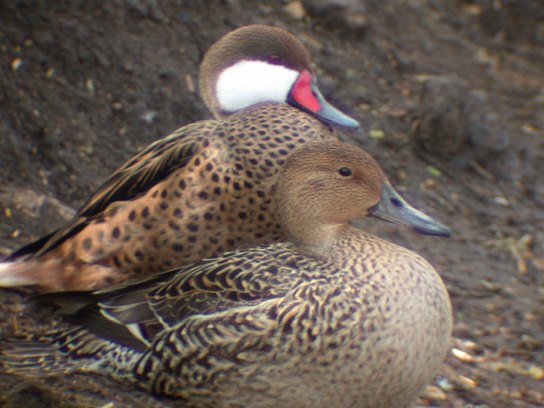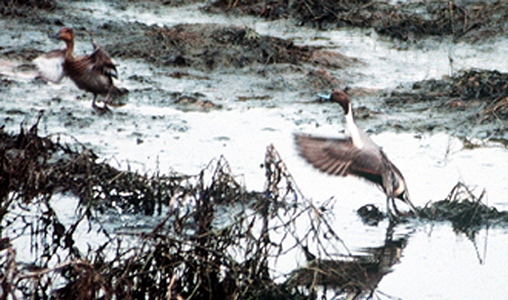|
Northern Pintail Anas acuta Pato Pescuecilargo, |
 |
|
Male - Photo: B. Hallett
|
| IDENTIFICATION: A dabbling duck with a long neck,
and a long, thin tail, obvious in silhouette, even from a distance. The
male has a brown head and white neck, while the dull brown female has
a shorter, but still pointed tail. Length: males: 57-76 cm.; females:
51-63 cm.; weight: 715-1,000 g.
VOICE: A short quack; a wheezy, whistled note: "whee." Audio (M. Oberle). HABITAT: Spends the winter on freshwater marshes and ponds, bays, and flooded agricultural fields. HABITS: Feeds in the evening and sometimes at night in shallow marshes and flooded fields on seeds, tubers, snails, crustaceans, and insects. It feeds by tipping its upper body into the water, and also occasionally grazes on dry land. When frightened, it takes off vertically from the water’s surface, and can wheel and turn quickly in mid-air. Pairs form while the Pintail is on the winter grounds. Once on the breeding grounds in North America, pairs fly over possible nesting sites until the female chooses a spot to make a nest scrape. The female lays 7-9 eggs, which she incubates for 22-25 days. While the female is laying or incubating, her mate will join nearby males to pursue any undefended female through the air and force her to the ground to copulate. The chicks leave the nest within hours of hatching and are led to food by the mother, who also broods them until 4-6 weeks after hatching. They fledge in July or August, 40-45 days after hatching. Pintails gather in large flocks at staging areas before migrating south in the fall. A Northern Pintail banded in Nova Scotia was recovered in Puerto Rico. STATUS AND CONSERVATION: An uncommon migrant wintering in Puerto Rico. It was probably far more common a century ago, before the extensive draining of wetlands on the North American prairies. Before the banning of lead shot, 9% of Pintails were found to have lead in their gizzards. An average of 329,000 are shot by hunters in North America each year. Botulism poisoning from the bacterium Clostridium botulinum kills many duck species in marshes of the prairie states and provinces of North America. The Northern Pintail was the most hard-hit species in a single 1997 botulism outbreak that killed perhaps a half million ducks at Old Wives Lake, Saskatchewan. RANGE: Breeds in the Old World, and over most of Alaska and Canada, south to Nova Scotia and California. It winters from British Columbia and coastal New England, south to Costa Rica, and the Greater Antilles. TAXONOMY: ANSERIFORMES; ANATIDAE; Anatinae |
|
 |
|
|
Female - Photo: B. Hallett
|



